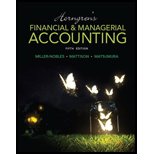
Concept explainers
Accounts receivable
Accounts receivable refers to the amounts to be received within a short period from customers upon the sale of goods and services on account. In other words, accounts receivable are amounts customers owe to the business. Accounts receivable is an asset of a business.
Bad debt expense is an expense account. The amounts of loss incurred from extending credit to the customers are recorded as bad debt expense. In other words, the estimated uncollectible accounts receivable are known as bad debt expense.
Direct write-off method:
This method does not make allowance or estimation for uncollectible accounts, instead this method directly write-off the actual uncollectible accounts by debiting bad debt expense and by crediting accounts receivable. Under this method, accounts would be written off only when the receivables from a customer remain uncollectible.
To identify: The period of reporting bad debt expense under direct write-off method.
Want to see the full answer?
Check out a sample textbook solution
Chapter 8 Solutions
Horngren's Financial & Managerial Accounting (5th Edition)
- Help pleasearrow_forwardPlease provide problem with accounting questionarrow_forwardJuan Leon Martinez posted Apr 7, 2025 11:25 AM Subscribe Hello everyone, Esteban is not performing in a professional manner in this scene. In fact, he is showing extreme unprofessional manners and unethical work ethic. Under no circumstance should he be using a company's tools or assets for his own benefit. You can also see he is trying not to get caught by any upper management due to him doing these actions after hours of work. As a manager, a great change I would do differently to make sure Esteban is not using the company's assets for their own benefit, would be coachings and sit down conversations. A sit down conversation can have the employee get an idea on how bad his actions are towards the company. This disciplinary of a coaching would be a written down statement from both manager and employee stating that he or she understands the actions they have done, which could lead to suspension or possibly termination. These unethical actions could lead to a great deal of financial loss…arrow_forward
- Principles of Accounting Volume 1AccountingISBN:9781947172685Author:OpenStaxPublisher:OpenStax College
 College Accounting, Chapters 1-27AccountingISBN:9781337794756Author:HEINTZ, James A.Publisher:Cengage Learning,
College Accounting, Chapters 1-27AccountingISBN:9781337794756Author:HEINTZ, James A.Publisher:Cengage Learning, Cornerstones of Cost Management (Cornerstones Ser...AccountingISBN:9781305970663Author:Don R. Hansen, Maryanne M. MowenPublisher:Cengage Learning
Cornerstones of Cost Management (Cornerstones Ser...AccountingISBN:9781305970663Author:Don R. Hansen, Maryanne M. MowenPublisher:Cengage Learning - Century 21 Accounting Multicolumn JournalAccountingISBN:9781337679503Author:GilbertsonPublisher:Cengage
 College Accounting (Book Only): A Career ApproachAccountingISBN:9781337280570Author:Scott, Cathy J.Publisher:South-Western College Pub
College Accounting (Book Only): A Career ApproachAccountingISBN:9781337280570Author:Scott, Cathy J.Publisher:South-Western College Pub





